Generative AI in Healthcare: Automate the Admin. Amplify the Care

By Teqfocus Team
11th June, 2025
“In healthcare, AI isn’t just about efficiency. It’s about freeing humans to do what only humans can.”
In most industries, artificial intelligence is discussed in terms of automation and cost savings. But in healthcare, the conversation is different. The core challenge isn’t just operational it’s deeply human.
The issue is time.
Time to care for patients. Time to focus. Time to make informed clinical decisions.
Let’s explore how generative AI is being used within healthcare workflows. Not as a shiny technology layer, but as a practical tool that helps clinical teams work more effectively and reclaim their time.
From Data Entry to Decision Support: What Generative AI is Solving
Clinical teams today face an overwhelming amount of manual tasks, especially within value-based care models. These include rewriting structured data into narrative summaries, reviewing fragmented records, and updating multiple systems with the same information.
The American Medical Association reported in 2024 that 58 percent of clinicians spend more time on administrative work than on patient care.
Generative AI is now embedded into platforms like Salesforce Health Cloud. Using tools such as Prompt Builder and Data Cloud, it allows care teams to work faster without compromising quality. This is not about replacing people, but helping them work more efficiently by reducing the burden of repetitive work.
Key Use Cases in Healthcare Workflows
Automated Member Summarization
AI gathers inputs from forms, dropdowns, and clinical notes, then creates a readable summary. Nurses simply review and approve.
Impact: Documentation time is reduced by about two-thirds. Staff can focus more on care delivery and outreach.
A 2024 pilot with a regional health plan showed a 72 percent reduction in documentation time. This allowed each nurse to manage up to 40 percent more patient interactions weekly.
Chart Deep-Dive Summaries
Instead of searching through dozens of EMR screens, AI provides a two-paragraph summary of a patient’s history, medications, and care risks.
Impact: This approach reduces cognitive workload, helps with clinical reasoning, and supports faster decisions.
McKinsey found that generative AI can reduce clinical decision-making time by up to 25 percent, improving patient flow without sacrificing quality.
Multichannel Communication Generation
AI creates emails, care updates, and eligibility reminders using approved medical tone and language.
Impact: Healthcare organizations can send consistent, personalized messages without increasing staff workload.
One large payer saw a 60 percent drop in the time it took to create patient-facing content, while still meeting compliance and tone requirements.
How This Builds on a Solid Foundation
These results don’t happen in isolation. They depend on a strong infrastructure;
- A unified data model that brings together forms, claims, and clinical records
- Integration across EHRs, CRM tools, and communication platforms
- Use of external models trained on clinical language and risk scoring
- Vector search capabilities that retrieve relevant unstructured data
- A focus on measurable improvements in patient care
Architecture Overview: Putting the Pieces Together
|
Layer |
Role in Workflow |
|
Salesforce Data Cloud |
Gathers real-time information from EMRs, forms, and claims |
|
Prompt Builder |
Creates structured prompts for AI workflows and review paths |
|
Vector Storage |
Allows relevant past cases to be retrieved based on similarity |
|
Einstein Trust Layer |
Maintains compliance, traceability, and governance |
|
Bring Your Own Model (BYOM) |
Adds advanced clinical reasoning and summarization logic |
This architecture can support both review-first processes and full automation, depending on the use case and level of clinical risk.
Outcomes: Improvements That Matter
|
Metric |
Before AI |
After GenAI |
|
Time per care summary |
45 minutes |
15 minutes |
|
Weekly nurse admin time |
12–15 hours |
5–6 hours |
|
Patient reach ratio |
1:5 |
1:8 or more |
|
Data visibility |
Fragmented |
Contextual and connected |
Forrester found that healthcare providers using generative AI improved their patient engagement metrics by up to 35 percent within six months of implementation.
Why Generative AI is Effective in Healthcare
Healthcare requires trust, compliance, and empathy. For generative AI to succeed in this space, it must meet higher standards;
- It must speak the language of healthcare
- It should support review and commit workflows for verification
- It needs to be governed with transparency and auditability
- It should support outcomes, not just productivity
Harvard Business Review noted that the true power of AI in medicine lies in helping clinicians focus more on patient care, not more on computers.
This is not just about technology. It’s about making time for better human connection.
Final Thought: Automate the Admin. Amplify the Care.
Generative AI doesn’t replace doctors, nurses, or case managers. What it replaces are the hours lost to documentation, searching, and cross-system updates.
When implemented well, AI allows clinicians to do what they do best – spend more time helping people.
This is where generative AI can make a real difference. It saves time. It improves care. It scales empathy.
Ready to See Generative AI in Action?
Let’s talk. Schedule a consultation on AI readiness and integration strategy.
